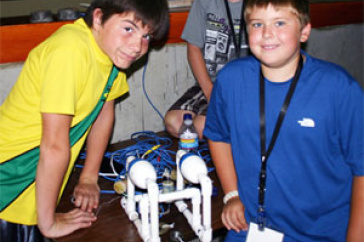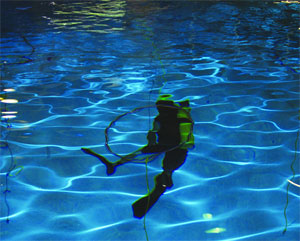UNH Tech Camp Provides Hands-On Science for Secondary Students

Brady McMillion and Sam Brady of Dover Middle School with their "Sea Perch" Remotely Operated Vehicle. Photo by Colleen Mitchell, CCOM/JHC.
DURHAM, N.H. - Brady McMillion and Sam Moore, rising seventh graders from Dover Middle School, peered into the deep test tank at the University of New Hampshire's Chase Ocean Engineering Laboratory recently, watching the boxy little Remotely Operated Vehicle (ROV) they built glide sleekly through the water.
"It's Santa's sleigh!" exclaimed Moore as the tethered ROV they maneuvered rose rapidly through the water column and bubbled to the surface. Indeed, so smooth was the ascent that the improbable, shoebox-sized apparatus built of small PVC pipes and three tiny, whirling propellers, mimicked flight. "This is so amazingly fun," Moore added.
In all there were seven similar ROVs swimming here last week (July 29, 2010) as part of UNH's Tech Camp 2010. The annual camp provides middle and high school students - primarily from New Hampshire - the opportunity to study and do hands-on projects with professionals in the fields of science, technology, engineering, and mathematics (STEM). In addition to the ROV-building group there were students deeply engaged with projects on oil spill cleanup, earthquake-proof buildings, rocket science, and aerodynamics.
In addition to UNH engineers and the middle and high school teachers involved in Tech Camp, divers and engineers from the Portsmouth Naval Shipyard (PNSY) helped guide the students through the process of building, testing, and modifying their ROVs. The Shipyard supplied the kits used to assemble the "Sea Perch" ROVs. Designed at the Massachusetts Institute of Technology, the ROV kit provides a simple, relatively inexpensive means of building a working underwater robot in the classroom. The Sea Perch project is aimed at igniting children's enthusiasm for science, technology, and engineering. The proof that it does just that was in full exhibit at the Chase Ocean Engineering Laboratory last week.

The seven two-student teams put their robots through constructed underwater courses in an effort to accomplish a number of "challenges" - put a cap on an "oil well," navigate through a series of hoops, snare various objects on the "seafloor," and pick up an object heavier than the ROV itself by working in pairs.
"The biggest hurdle for them today is, after making some trial runs, to modify their ROVs so they can tackle a specific task," said Shawn Gygax, a Tech Camp counselor from Barrington Middle School. He added, "Right now each group is frantically trying to figure out how to make modifications in order to conquer the particular challenge."
Each ROV has a "hood"-mounted camera that allowed students to see where their robots were going as they guided them via a small, handheld control box with toggle switches that maneuvered the little submersibles. In addition, three cameras mounted inside the deep tank provided students with enough visual information to orient themselves. Still, it was like playing a live video game and even though the ROVs are remarkably responsive to commands, getting the hang of steering something in 20 feet of water was challenging.
Gygax points out that the students did more than simply assemble the Sea Perch kits; to create a working ROV each had to wire all the electrical switches, build the control box, and waterproof the electric motors (that spin the propellers) in wax. Moreover, the kids needed to learn some fundamental science about submersibles - how things float, sink, and distribute weight - and spent a lot of classroom time wracking their brains over various formulas.
Perched on a floating platform in the deep tank, Dale Delisle of the Naval Shipyard's Deep Submergence System Program noted that the Navy is becoming increasingly involved in public outreach like this in an effort to attract students to the STEM disciplines and become potential members of the future engineering workforce.
"During the last three weeks, 63 campers were afforded some outstanding hands-on STEM opportunities," says Robert Henry, Tech Camp director and associate dean for academic affairs at the UNH College for Engineering and Physical Sciences. Henry adds that the camp activities "would not have been possible" without the generous assistance (people, supplies, scholarships and donations) from several companies and organizations, including PNSY, Liberty Mutual, Whelen Engineering, several UNH research centers and NH EPSCoR.
"PNSY alone provided at least 10 volunteers, the Sea Perch kits, tons of equipment and an extraordinary experience for the campers. I cannot imagine what it would cost for me to replicate the Sea Perch project, and we are looking towards a long-term relationship with PNSY and others so that Tech Camp can continue to provide regional seventh- through tenth-grade students with an affordable and exciting engineering/science camp," Henry says.
The University of New Hampshire, founded in 1866, is a New England liberal arts college and a major research university with a strong focus on undergraduate-oriented research. A land, sea and space-grant university, UNH is the state's flagship public institution, enrolling 12,200 undergraduate and 2,200 graduate students.
-30-
Photographs: http://www.eos.unh.edu/newsimage/brady_sam_with_rov_lg.jpg; http://www.eos.unh.edu/newsimage/navy_diver_setting_up_hula_hoop_lg.jpg
Captions: Brady McMillion and Sam Brady of Dover Middle School with their "Sea Perch" Remotely Operated Vehicle; A Navy diver sets up the underwater "challenges" course in the deep tank at the UNH Chase Ocean Engineering Laboratory. Photos by Colleen Mitchell, CCOM/JHC.
Latest News
-
December 4, 2025
-
November 26, 2025
-
November 6, 2025
-
November 5, 2025
-
October 24, 2025














































